
Max Adventure
28 September 2013 | Serifos
26 September 2013 | Kithnos
18 September 2013 | Corinth
16 September 2013
15 September 2013 | Galaxhidi
14 September 2013 | Entrance to Gulf of Corinth
13 September 2013 | Patras
10 September 2013
31 August 2013 | Preveza
30 August 2013 | The Meteora
25 August 2013 | North Ionian
18 August 2013 | Northern Ionian
07 August 2013 | Ionian
19 July 2013 | Ionian
28 June 2013 | Paleros
19 June 2013 | Vlieho
18 June 2013 | Vlieho
18 June 2013 | Skorpios Island
16 June 2013 | Nidri
16 June 2013 | Lefkada and Maganisi
Cycladic Chora
28 September 2013 | Serifos
Carole/Still Sunny
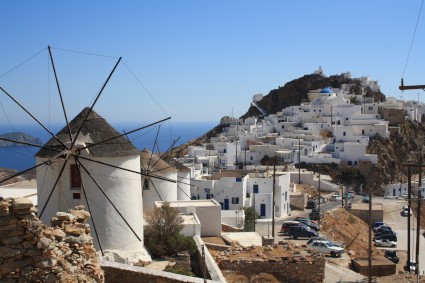
Disappointed to motor all the way to Serifos but what a great view of the Chora as we came down the East coast of the island to Livahdi, our harbour for the night. Having just discovered what a Chora is it was great to see such a fine example of one, high on the mountainside. Chora means main settlement, which in days gone by was always built high up to afford a good view of approaching pirates. Apparently, this gave time to hide your valuables and your daughters! The dwellings in the Chora are all painted white with blue doors and shutters and nearly all of them have flat roofs: very different architecture to that of the Ionian. The landscape is also very different: we have noticed how barren and brown these islands look in comparison to the greenness of the Ionian.
There was space to moor on the quay so we took it and Dragonfly found a space on the other side.
Next morning we took the local bus up to the Chora, 1.6 Euros each, and a fifteen minute ride. This was the first Chora we had visited so the cameras were working overtime. The views were incredible all around and the light was perfect for photos.
The little streets are pedestrian only, oh and donkeys, which we saw doing many jobs but perhaps the most interesting was the refuse collection. The donkey walks the streets and the people pop out of their house and give the guy their small bags of rubbish which he puts on the donkey and continues on his way.
With whitewashed buildings, quaint streets and jewel bright bougainvillea everywhere it was a feast for the eyes. Peaceful too as it is now September and there were only three or four other foreigners around.
After a lovely lunch at the Blue Dream, overlooking the Chora, we decided to walk down. We had seen steps as we came up in the bus, that wended their way through the Chora and down to the coast again. It was such a lovely walk down, although we were glad we had not walked up, it was still quite hot in the sun but around every corner was another view to photograph – thank goodness for digital!
Once back on Max, Ian spotted Nostromo, with John and Vanessa on board, anchored in the bay. Just as he did this they walked along the quay at the back of Max. A few beers later, with Ann and David too, we had exchanged all our news since we had last met. It is always so lovely to ‘bump into’ other boats we know in this random way and as we are all beginning to head to Turkey for the winter now I guess we will see more and more boats along the way.
Despite being the end of September we are still having summer weather. The sea temperature has fallen a bit and the evenings are slightly cooler but we are still sleeping under a sheet – hard to believe when people back home have their heating on, but one of the main attractions of cruising in this area.
There was space to moor on the quay so we took it and Dragonfly found a space on the other side.
Next morning we took the local bus up to the Chora, 1.6 Euros each, and a fifteen minute ride. This was the first Chora we had visited so the cameras were working overtime. The views were incredible all around and the light was perfect for photos.
The little streets are pedestrian only, oh and donkeys, which we saw doing many jobs but perhaps the most interesting was the refuse collection. The donkey walks the streets and the people pop out of their house and give the guy their small bags of rubbish which he puts on the donkey and continues on his way.
With whitewashed buildings, quaint streets and jewel bright bougainvillea everywhere it was a feast for the eyes. Peaceful too as it is now September and there were only three or four other foreigners around.
After a lovely lunch at the Blue Dream, overlooking the Chora, we decided to walk down. We had seen steps as we came up in the bus, that wended their way through the Chora and down to the coast again. It was such a lovely walk down, although we were glad we had not walked up, it was still quite hot in the sun but around every corner was another view to photograph – thank goodness for digital!
Once back on Max, Ian spotted Nostromo, with John and Vanessa on board, anchored in the bay. Just as he did this they walked along the quay at the back of Max. A few beers later, with Ann and David too, we had exchanged all our news since we had last met. It is always so lovely to ‘bump into’ other boats we know in this random way and as we are all beginning to head to Turkey for the winter now I guess we will see more and more boats along the way.
Despite being the end of September we are still having summer weather. The sea temperature has fallen a bit and the evenings are slightly cooler but we are still sleeping under a sheet – hard to believe when people back home have their heating on, but one of the main attractions of cruising in this area.
Welcome to the Cyclades
26 September 2013 | Kithnos
Carole/Sunny
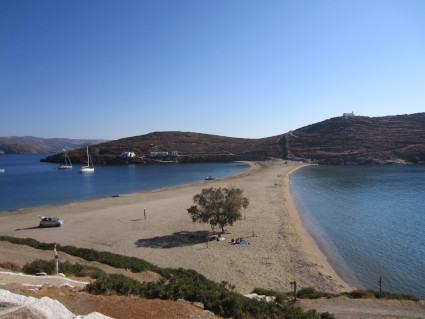
After the excitement of the canal we spent three peaceful nights at anchor in Epidhavros followed by three noisy nights in Poros. The anchorage was idyllic with great sunsets and good swimming, no swell or wind and a lovely little town. Poros is best described as swelly and smelly! The ferry wash gave us severe problems and the shape of the quay meant lots of anchor tangles, thankfully not us but we had to remain a vigilant watch!
So it was a pleasant relief to leave the Saronics after our brief stay and head east to the Cyclades and the island of Kithnos.
The first night we anchored in Ormos Kolona: great swimming and as pretty as a postcard. There was no town here just one taverna up from the sand bar, which incidentally created a lovely sandy beach something lacking in the Ionian. However that night some swell crept into the bay and we had a rolly night so we decided to go round to the other side of the bar.
Before moving the boats we went for a walk ashore with Ann and David from Dragonfly. Nisos Ay Loukas is joined to the mainland by the sandbar which was a handy place to leave Min while we explored. Walking up to the top of the hill we added stones to the cairns before heading off to look at the little chapel and the ancient ruins. The ubiquitous goat herd arrived, bells merrily dinging as they wandered across the steep hillside, perfectly adding to the tranquil rural scene – such a breath of fresh air, literally after Poros!
We returned to the boats and motored the 2km around the island we had just explored to the other side of the sand bar where we re-anchored and then went ashore again for a long lunch at the tavern. When we arrived there was a beautiful aroma coming from the kitchen. Upon trying to find out what it was, we could see the pot on the stove we discovered that the cook did not speak a word of English, but through gesticulation we discovered lunch was being served from 13.30 hrs so we settled down on the outside terrace with a cold beer and the menu. Not quite sure why she gave us a menu each because everything was off except what was in the pot!!
Which turned out to be goat in a delicious sauce- unsurprisingly we all chose the goat, amidst much laughter from both sides. Our long lunch was followed by a swim and a lazy evening and a much better night.
In the morning we went ashore again and carried Min over the sandbar and put her back in the water to visit a beach on the mainland side of Ormos Kolona where there was a hot spring. So many of these islands are on volcanoes or created through volcanic action or earthquakes that hot springs are not that unusual, at least to them! To us it was a great novelty as we lay in water as hot as a bath back home and looked out over the Aegean. The hot water was bubbling up in one corner of the rocky pool, nearest Ann, who had to face lots of suspicious looks from the rest of us as we lazed in languorous mood!
Returning to Max we pulled the anchor up to head to the next island – all of 23nm away! First impression of the Cyclades were most favourable, looking forward to more.
So it was a pleasant relief to leave the Saronics after our brief stay and head east to the Cyclades and the island of Kithnos.
The first night we anchored in Ormos Kolona: great swimming and as pretty as a postcard. There was no town here just one taverna up from the sand bar, which incidentally created a lovely sandy beach something lacking in the Ionian. However that night some swell crept into the bay and we had a rolly night so we decided to go round to the other side of the bar.
Before moving the boats we went for a walk ashore with Ann and David from Dragonfly. Nisos Ay Loukas is joined to the mainland by the sandbar which was a handy place to leave Min while we explored. Walking up to the top of the hill we added stones to the cairns before heading off to look at the little chapel and the ancient ruins. The ubiquitous goat herd arrived, bells merrily dinging as they wandered across the steep hillside, perfectly adding to the tranquil rural scene – such a breath of fresh air, literally after Poros!
We returned to the boats and motored the 2km around the island we had just explored to the other side of the sand bar where we re-anchored and then went ashore again for a long lunch at the tavern. When we arrived there was a beautiful aroma coming from the kitchen. Upon trying to find out what it was, we could see the pot on the stove we discovered that the cook did not speak a word of English, but through gesticulation we discovered lunch was being served from 13.30 hrs so we settled down on the outside terrace with a cold beer and the menu. Not quite sure why she gave us a menu each because everything was off except what was in the pot!!
Which turned out to be goat in a delicious sauce- unsurprisingly we all chose the goat, amidst much laughter from both sides. Our long lunch was followed by a swim and a lazy evening and a much better night.
In the morning we went ashore again and carried Min over the sandbar and put her back in the water to visit a beach on the mainland side of Ormos Kolona where there was a hot spring. So many of these islands are on volcanoes or created through volcanic action or earthquakes that hot springs are not that unusual, at least to them! To us it was a great novelty as we lay in water as hot as a bath back home and looked out over the Aegean. The hot water was bubbling up in one corner of the rocky pool, nearest Ann, who had to face lots of suspicious looks from the rest of us as we lazed in languorous mood!
Returning to Max we pulled the anchor up to head to the next island – all of 23nm away! First impression of the Cyclades were most favourable, looking forward to more.
The Most Expensive Canal in the World
18 September 2013 | Corinth
Carole/Sunny and no wind!

With thoughts of Delphi lingering in our heads the next day we headed south again, to Corinth Yacht Harbour, a mile away from the most expensive canal on the planet. Per metre it works out the most expensive canal to transit but we had decided last year it was an experience we wanted to have.
Dragonfly and Jolli Jumper were with us, we planned to take photos of each other on the way through! We had a windy night in the yacht harbour which necessitated Dragonfly to change berth and caused Jolli Jumper to have to leave the harbour and anchor in the commercial port. We were relieved when we woke up that the day was bright and calm as we had heard that the wind makes the entrance to the canal more challenging.
We called the Canal Authorities at 0700hrs and asked for permission to transit and we were asked to wait 20 minutes. Traffic is only one way through the canal due to the size. It is 3.2 miles long, 25m wide, yes metres, the maximum permitted draught is 6.5m and the limestone from which it is cut rises to 79m above sea level at its highest point. The maximum air height is 52m because of the bridges over the canal. None of those dimensions were a problem for Max.
Approaching the canal we were asked to wait a bit longer and then we saw why: three yachts came motoring out in front of us. Then it was our turn. We were asked to go at full speed but we had 2knots of current with us so going at 5.4kts boat speed turned into 7.4kts SOG (speed over ground) which was fast enough to keep the canal authorities happy.
There are two hydraulic bridges at either end of the canal that lower into the water to allow boats to pass and use a traffic light system. We had a green light as they were already open for the other yachts to come out.
Dragonfly led the way, followed by us with Jolli Jumper bringing up the rear. The cameras were clicking all the way through as we looked in awe at the engineering required to make the canal. It was built, in its present form, by a French company and completed by the Greeks in 1893. It was enlarged after damage suffered in the Second World War. There are now three bridges: one rail and two road.
Ian and I had driven over the canal and looked down and remembered thinking how deep it was. Now, from the bottom, we didn't think it was a high as we thought! However, it was very narrow, not for us in Max but for bigger ships we couldn't imagine how they could navigate, especially when we saw some rocks just under the water in some places. It was surprisingly green at the beginning and end and the limestone rocky section was really in the middle.
At the speed we were travelling it took us about half an hour to get through and in no time we were tied up on the dock on the starboard side as we came out. The formalities needed to be completed here, including paying. The cost for us was 244 Euros, roughly what we expected so no shocks there. However, not sure we will go back the other way any time soon!
And now we are in the Aegean Sea, looking forward to the Saronics, Cyclades, and Dodecanese islands, bring it on....
Dragonfly and Jolli Jumper were with us, we planned to take photos of each other on the way through! We had a windy night in the yacht harbour which necessitated Dragonfly to change berth and caused Jolli Jumper to have to leave the harbour and anchor in the commercial port. We were relieved when we woke up that the day was bright and calm as we had heard that the wind makes the entrance to the canal more challenging.
We called the Canal Authorities at 0700hrs and asked for permission to transit and we were asked to wait 20 minutes. Traffic is only one way through the canal due to the size. It is 3.2 miles long, 25m wide, yes metres, the maximum permitted draught is 6.5m and the limestone from which it is cut rises to 79m above sea level at its highest point. The maximum air height is 52m because of the bridges over the canal. None of those dimensions were a problem for Max.
Approaching the canal we were asked to wait a bit longer and then we saw why: three yachts came motoring out in front of us. Then it was our turn. We were asked to go at full speed but we had 2knots of current with us so going at 5.4kts boat speed turned into 7.4kts SOG (speed over ground) which was fast enough to keep the canal authorities happy.
There are two hydraulic bridges at either end of the canal that lower into the water to allow boats to pass and use a traffic light system. We had a green light as they were already open for the other yachts to come out.
Dragonfly led the way, followed by us with Jolli Jumper bringing up the rear. The cameras were clicking all the way through as we looked in awe at the engineering required to make the canal. It was built, in its present form, by a French company and completed by the Greeks in 1893. It was enlarged after damage suffered in the Second World War. There are now three bridges: one rail and two road.
Ian and I had driven over the canal and looked down and remembered thinking how deep it was. Now, from the bottom, we didn't think it was a high as we thought! However, it was very narrow, not for us in Max but for bigger ships we couldn't imagine how they could navigate, especially when we saw some rocks just under the water in some places. It was surprisingly green at the beginning and end and the limestone rocky section was really in the middle.
At the speed we were travelling it took us about half an hour to get through and in no time we were tied up on the dock on the starboard side as we came out. The formalities needed to be completed here, including paying. The cost for us was 244 Euros, roughly what we expected so no shocks there. However, not sure we will go back the other way any time soon!
And now we are in the Aegean Sea, looking forward to the Saronics, Cyclades, and Dodecanese islands, bring it on....
A Day in Delphi
16 September 2013
Carole/Sunny/Showery
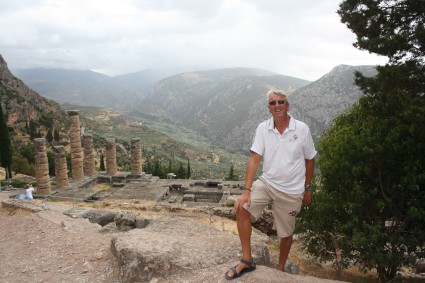
It would be nigh on impossible to pass by so close to Delphi without visiting this impressive ancient site. So, Dragonfly, Jolli Jumper and ourselves set off on the bus from the square in Galaxhidi to go up the mountain and explore.
I had always known of Delphi, as have most people, but I didn’t actually know much about the history of the place.
Delphi occupies a high mountain terrace dwarfed either side by the ominous crags of Mount Parnassos. For centuries this was the religious and spiritual centre of the ancient Greek world. According to tradition, Delphi was the geographical centre of the world, the omphalos (“navel”), the meeting point of two eagles dispatched by Zeus from the ends of the universe to find the centre of the world!
However, it would seem that it was the prescence of the oracle that really put Delphi on the map. The first oracle established here was dedicated to Gaia (Mother Earth) and Poseidon (Earth Shaker). The serpent Python, son of Gaia, lived in a nearby chasm that exuded strange vapours, and communication was made through the Pythian priestess. Python was later slain by young Apollo, who supposedly arrived in the form of a dolphin, hence the name Delphi.
Apollo replaced Python in the ninth century BC and following this the sanctuary became the centre for an association of city states, known as the Amphyctionic League. The oracle was increasingly respected and a steady stream of pilgrims made their way to Delphi to receive divine direction in matters of war, worship, love or business.
As far as we could tell the oracle worked like this: the Pythian priestess was positioned on a tripod over the oracular chasm. The vapours from the chasm reduced her to frenzied, incoherent and undoubtedly prophetic mutterings. Crucially, an attendant priest would then ‘interpret’ her utterings, usually in an ambiguous answer, to the waiting pilgrim. Said pilgrim will have paid a set fee and made a sacrifice, a goat, boar or even a bull, and then waited to submit a question on a lead tablet.
The oracle must have offered predominantly sound advice or I guess it would not have retained its popularity for so long. This may have been because the Delphic priests, who ‘intertreted’ the answers, were better informed than any other corporate body at that time. With the Amphyctionic League acting as a ‘United Nations’ of the Greek city states they were able to amass a huge wealth of political, economic and social information that informed their ‘interpretations’.
Delphi also had huge financial wealth. The Greek city states rivalled each other in their display of ostentatious gifts to Delphi. We walked through the paved Sacred Way that used to house statues of gold, bronze and painted marble figures. Individual Greek states used these memorials as a display of strength, for example after defeating another state in battle, so it appears that as time went on the monuments became more lavish to outdo each other.
Halfway up the site there is the amazing Polygonal Wall, whose irregular interlocking blocks have withstood, intact, all earthquakes. No mean feat round here where every other place seems to have been destroyed by earthquakes over the years! It is covered with inscriptions, like so many of the rocks here, but these mostly refer to the emancipation of slaves; Delphi was one of the few places where such freedom could be made official by an inscribed register.
Most of the Delphi site that we saw was rediscovered towards the end of the seventeenth century and explored, haphazardly from 1838 onwards; real excavation began only in 1892 when the French School of Archaeology leased the land. By 1903 most of the excavations and reconstructions we saw were complete.
We spent ages walking up the rough stone steps and paths as we explored, and listened in to tour guides telling their groups about the history and meaning of the different sites – most useful and free! We were nearly at the top when the weather changed and the heavens opened! Sheltering under the few trees around kept us reasonably dry until we could walk down in between the showers and make for the museum. We spent an absorbed couple of hours in there – it was so well done. Sue was able to sketch in the dry, one of the staff even brought her a seat, and there was so much to choose from to draw.
Catching the bus back down the mountain gave us a lovely view way out to sea over the Gulf of Corinth and a chance to reflect on the day. We had been lucky with the weather as we had seen most of the site before the rain came: it was definitely one of the must see sights of Greece!
I had always known of Delphi, as have most people, but I didn’t actually know much about the history of the place.
Delphi occupies a high mountain terrace dwarfed either side by the ominous crags of Mount Parnassos. For centuries this was the religious and spiritual centre of the ancient Greek world. According to tradition, Delphi was the geographical centre of the world, the omphalos (“navel”), the meeting point of two eagles dispatched by Zeus from the ends of the universe to find the centre of the world!
However, it would seem that it was the prescence of the oracle that really put Delphi on the map. The first oracle established here was dedicated to Gaia (Mother Earth) and Poseidon (Earth Shaker). The serpent Python, son of Gaia, lived in a nearby chasm that exuded strange vapours, and communication was made through the Pythian priestess. Python was later slain by young Apollo, who supposedly arrived in the form of a dolphin, hence the name Delphi.
Apollo replaced Python in the ninth century BC and following this the sanctuary became the centre for an association of city states, known as the Amphyctionic League. The oracle was increasingly respected and a steady stream of pilgrims made their way to Delphi to receive divine direction in matters of war, worship, love or business.
As far as we could tell the oracle worked like this: the Pythian priestess was positioned on a tripod over the oracular chasm. The vapours from the chasm reduced her to frenzied, incoherent and undoubtedly prophetic mutterings. Crucially, an attendant priest would then ‘interpret’ her utterings, usually in an ambiguous answer, to the waiting pilgrim. Said pilgrim will have paid a set fee and made a sacrifice, a goat, boar or even a bull, and then waited to submit a question on a lead tablet.
The oracle must have offered predominantly sound advice or I guess it would not have retained its popularity for so long. This may have been because the Delphic priests, who ‘intertreted’ the answers, were better informed than any other corporate body at that time. With the Amphyctionic League acting as a ‘United Nations’ of the Greek city states they were able to amass a huge wealth of political, economic and social information that informed their ‘interpretations’.
Delphi also had huge financial wealth. The Greek city states rivalled each other in their display of ostentatious gifts to Delphi. We walked through the paved Sacred Way that used to house statues of gold, bronze and painted marble figures. Individual Greek states used these memorials as a display of strength, for example after defeating another state in battle, so it appears that as time went on the monuments became more lavish to outdo each other.
Halfway up the site there is the amazing Polygonal Wall, whose irregular interlocking blocks have withstood, intact, all earthquakes. No mean feat round here where every other place seems to have been destroyed by earthquakes over the years! It is covered with inscriptions, like so many of the rocks here, but these mostly refer to the emancipation of slaves; Delphi was one of the few places where such freedom could be made official by an inscribed register.
Most of the Delphi site that we saw was rediscovered towards the end of the seventeenth century and explored, haphazardly from 1838 onwards; real excavation began only in 1892 when the French School of Archaeology leased the land. By 1903 most of the excavations and reconstructions we saw were complete.
We spent ages walking up the rough stone steps and paths as we explored, and listened in to tour guides telling their groups about the history and meaning of the different sites – most useful and free! We were nearly at the top when the weather changed and the heavens opened! Sheltering under the few trees around kept us reasonably dry until we could walk down in between the showers and make for the museum. We spent an absorbed couple of hours in there – it was so well done. Sue was able to sketch in the dry, one of the staff even brought her a seat, and there was so much to choose from to draw.
Catching the bus back down the mountain gave us a lovely view way out to sea over the Gulf of Corinth and a chance to reflect on the day. We had been lucky with the weather as we had seen most of the site before the rain came: it was definitely one of the must see sights of Greece!
Cruiser Ducks
15 September 2013 | Galaxhidi
Carole/Sunny
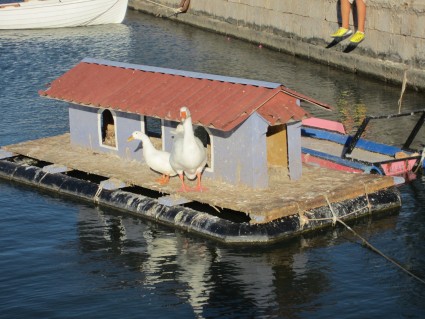
Even the ducks have a relaxed cruiser lifestyle in Galaxhidi !
Anniversary Bridge
14 September 2013 | Entrance to Gulf of Corinth
Carole/Sunny/Windy
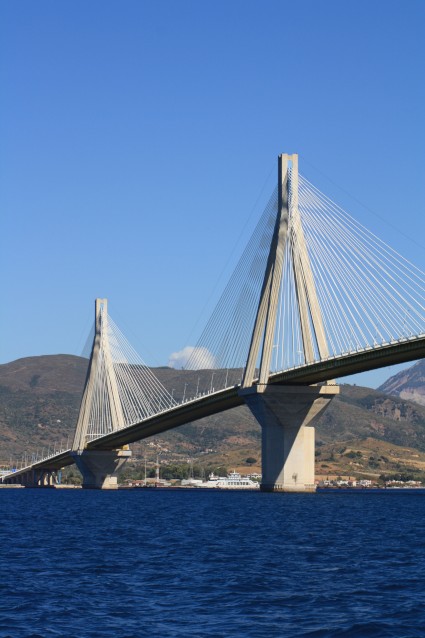
To enter the Gulf of Corinth we passed under the spectacular Rion-Andirrion suspension bridge. This bridge, completed in 2004, is the longest cable-stayed bridge in the world, at 2.252km, and has three navigable channels each 560m wide between four pillars giving an air height of 25-45m.
Max has an air height of 20m so this was no problem for us. We had to call Rion Traffic on the VHF to obtain permission to transit the bridge and they then told which of the three channels we were to use. Larger vessels get to use the middle channel and we used the south channel. We had to keep a good lookout for the ferries which ply between Rion and Andiirion as they crossed directly in front of us.
Amazing spectacle on our 26th Wedding Anniversary!
Max has an air height of 20m so this was no problem for us. We had to call Rion Traffic on the VHF to obtain permission to transit the bridge and they then told which of the three channels we were to use. Larger vessels get to use the middle channel and we used the south channel. We had to keep a good lookout for the ferries which ply between Rion and Andiirion as they crossed directly in front of us.
Amazing spectacle on our 26th Wedding Anniversary!
| Vessel Name: | Maximilian |
| Vessel Make/Model: | Moody 47 |
| Hailing Port: | Southampton |
| Crew: | Ian and Carole Clothier |
| About: | Ian and Carole are cruising in the Eastern Mediterranean, making the most of every day. |
| Extra: | Currently cruising around the Coastline of Turkey |
Gallery not available
Max
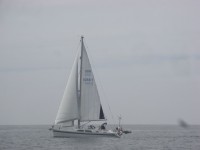
Who: Ian and Carole Clothier
Port: Southampton